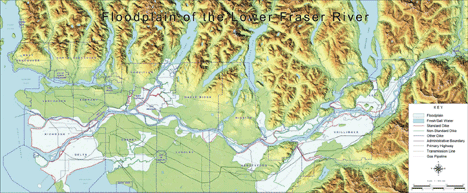
The Dutch know a thing or two about flood defences. Half their country lies at or below sea level. Its inhabitants have been battling the North Sea by raising dikes and reclaiming the land behind them since the Middle Ages. So it should tell us something when the Dutch decide -- as they did last year -- that dikes have, if not entirely outlived their usefulness, then come close to reaching their limit; that it's time to try something else.
As work crews take a breather from the frantic pace to meet a mid-May deadline to bolster the lower B.C. mainland's dikes along the Fraser River, and flood forecasters cast anxious eyes up to the interior mountains still covered by heavy snow, it's also worth contemplating some striking similarities between our circumstances and those of the Netherlands.
Although the image that comes first to mind of the Dutch polders is of vast earthworks holding back the sea, in fact the country is also at risk from the land. Like the Lower Mainland, the Netherlands occupies the delta of a great river. The Rhine drains more than 184,000 square kilometres of Western Europe -- an area not so far off the Fraser's 233,000 square kilometre watershed.
Like British Columbia's Lower Mainlanders, the Dutch make the most of their relative scrap of land, leading to high population densities. The main outlet of the Rhine runs right through Rotterdam, with a metro population of 1.2 million people. A second arm of the river (the Ijssel) eventually reaches the sea through Amsterdam, whose metro population is more than 6 million. Over recent decades, both the number of people living behind the dikes that line the Rhine, its tributaries and secondary branches, and the value of their properties, have increased.
So has the risk of high water on the river -- just as it has increased here.
Dikes can worsen flood effects
What has not increased is the protection offered by the Dutch river dikes. If anything, that has diminished. As a Dutch government document describes the experience of the last few years:
"The land behind the river embankments is becoming more heavily used and populated. More homes are being built and affluence is on the rise. So a flood would have disastrous results. High river discharges can be expected as a result of climate changes, which makes these areas even more vulnerable. While new dike reinforcements are an option and will reduce the risk of flooding, if a flood occurs anyway, the effects will be even greater."
Sound familiar? It should. As a previous Tyee report detailed, the security offered by the province's recent rushed investment of $33 million on last-minute repairs to the Lower Mainland's 300 kilometres of dikes is temporary at best -- and could prove illusory.
Which is what makes the Dutch government's 2006 decision to reverse a centuries-old strategy in favour of a new approach all the more significant for us here in B.C.
'Room for the River'
The new strategy has a descriptive name. It's called "Room for the River." The name captures the essence of a nine-year, €2.2 billion (C$3.4 billion) program to give the Rhine delta's residents better protection from future floods while improving the aquatic and riparian environment by, as the name implies, giving the periodic flows of high water more room to spread out over portions of the river's historic floodplain.
It's being done several ways:
- Where it can be done without harming healthy ecosystems, foreshore areas between the river and dikes are being excavated to lower their level and leave more room to hold floodwater.
- A dozen dikes are being moved further away from the river, again to give the Rhine room to flood; some homes and buildings will be torn down to accommodate the realignment.
- Land along an upstream reach of the Dutch portion of the river is being set aside as a "last-resort retention area" that will be flooded in extreme high-water emergencies.
It should be noted that the Dutch are not turning their backs entirely on the virtues of civil engineering. A number of weak spots in the existing Rhine river dikes will be fortified. And four new emergency floodways, on the same model that directs high water in Manitoba's Red River around Winnipeg, are to be built to provide the Rhine with a way around urban chokepoints.
Once everything is done, the Dutch, whose entire country depends on their being right, expect the roomier Rhine channel to be able to safely accommodate a peak flow as much as 18 per cent above the existing record.
Other natural remedies
The Netherlands isn't the only place putting trust in a more natural strategy for flood control. Florida, on its Kissimmee River, and Wisconsin on its Menominee, have implemented similar strategies. After the worst flood ever on the Mississippi, when it breached its levees in some 500 places in 1993, killing 50 people and doing C$18 billion worth of damage, a federal study group recommended giving the Old Man River more room to spread out in future floods (perhaps predictably, the Clinton Administration, which commissioned the report, dawdled on implementing it; the Bush Administration has flatly ignored it).
Making room for rivers to do what comes naturally when their waters run high is neither rocket science nor a novel concept. But remarkably it appears to have been given little if any serious consideration in British Columbia. "I'm not sure how much it's been looked at," Steve Litke, the program officer in charge of coordinating flood research and planning at the Fraser Basin Council, confided. "I haven't seen anything in the last five or 10 years that I've been here."
Like some others I spoke to, Steve wonders whether we're not too late to give the Fraser room to flood. The Lower Mainland, he points out, is already heavily developed -- in many places right down to the river's edge. And development continues, even in some of the highest-risk locations like the river bend at Mission.
But then, the same is true of the Netherlands.
Another expert familiar with the Fraser who initially shared Steve's reservations, relented after some thought. Relatively undeveloped areas are still to be found along the lower river, hydrological engineer Adrian Chantler noted: between Hope and Mission, on Nicomen and Barnston Islands (currently 'protected' by inadequate dikes) and the agricultural eastern end of Lulu Island, whose western half is occupied by Richmond. An interesting dimension of river behaviour, he pointed out, is that any extra room gained for the river downstream would also lower flood peaks for kilometers upstream.
Look past the dike
A more natural strategy for flood control may not be a complete answer to future flood threats on the Fraser. As the Dutch have determined, we're likely still to need some dikes. But giving the river more room could mean those dikes would not need to be as high, or need continual raising.
Equally, giving the river back some of its former elbow-room in the delta doesn't exhaust the possibilities for natural flood control. The water that threatens the Lower Mainland, after all, comes from upstream tributaries: the upper Fraser, Nechako and Thompson rivers, among others. What happens there affects what happens here: a decision to clear-cut trees killed by the pine-beetle epidemic, for example, could nearly double stream flow in valleys where the forest was removed.
Similarly, the benefits of a more laissez-flow approach to high water could extend beyond flood protection. Riparian habitats would benefit. So would groundwater reserves that are under pressure from municipal wells in Langley Township and other parts of the Fraser Valley: periodic floods are one way those aquifers used to be replenished, and could be again. Natural floods also help restore the nutrients in floodplain soils, a potential benefit to agriculture.
Most of the Lower Mainland's flood defences are relics of the last century's devotion to big, one-size-fits-all solutions: engineering by brute force. The new century is discovering the elegance and effectiveness of myriad diverse, dispersed solutions. As the Dutch masters are showing, however, it helps to rethink conventional wisdom -- and look past the dike.
Related Tyee stories:
- Rush Job on Dikes: 'Band-aids'
Thwarting Fraser floods will take 'sustained effort' say experts. - Billion-Dollar Development Planned for Flood-Prone Shore
Homework will be done says Mission mayor. - Fraser River Will Surge over Dikes, Experts Find
Study predicts 'multiple dike failures.' But government has cut warning system.
















Tyee Commenting Guidelines
Comments that violate guidelines risk being deleted, and violations may result in a temporary or permanent user ban. Maintain the spirit of good conversation to stay in the discussion.
*Please note The Tyee is not a forum for spreading misinformation about COVID-19, denying its existence or minimizing its risk to public health.
Do:
Do not: